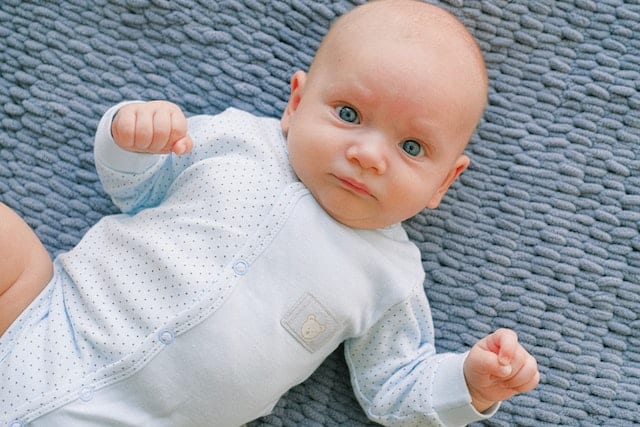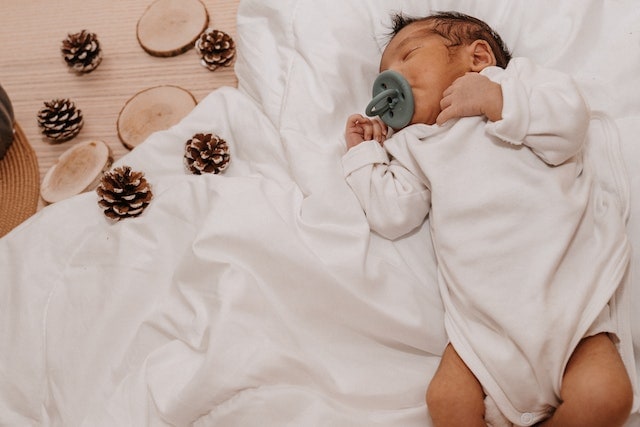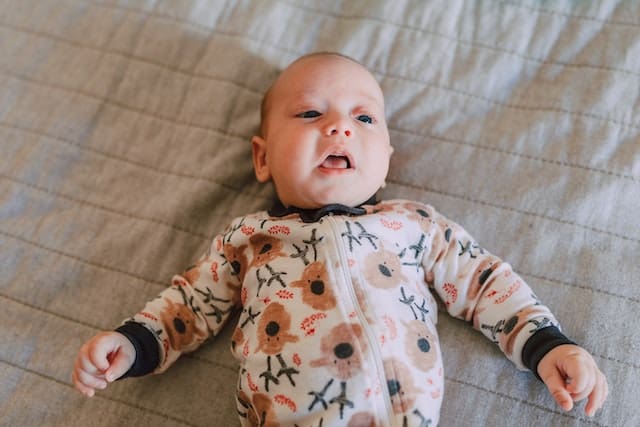Babies are adorable in their onesies, but as they grow, parents may wonder when it’s time to transition to other clothing options. Onesies are a staple in a baby’s wardrobe, but they are not always practical or necessary.
Understanding when babies typically stop wearing onesies and the factors that influence this transition can help parents make informed decisions about their baby’s clothing.
Several factors can influence the transition from onesies, including the baby’s age, developmental milestones, and the season.
Parents should also consider their baby’s comfort and mobility when choosing clothing options. Alternatives to onesies, such as rompers and two-piece outfits, can provide more flexibility and comfort for older babies.
Key Takeaways
- Babies typically stop wearing onesies around six to nine months of age.
- Factors such as developmental milestones and the season can influence the transition from onesies.
- Alternatives to onesies, such as rompers and two-piece outfits, can provide more flexibility and comfort for older babies.
Understanding Baby Onesies
Baby onesies, also known as bodysuits, are a popular type of baby clothing that covers the torso and snaps together at the bottom. They are a staple in most baby wardrobes and come in a variety of designs and brands.
Onesies are typically made from soft, breathable materials such as cotton, making them comfortable for babies to wear. They also come in various sleeve lengths, from short-sleeved to long-sleeved, to accommodate different weather conditions.
One of the benefits of onesies is their convenience. They are easy to put on and take off, and the snap closure at the bottom allows for quick diaper changes. Some onesies even have zippered closures for added convenience.
When it comes to sizing, onesies are typically available in newborn, 0-3 months, 3-6 months, 6-9 months, and so on. It’s important to choose the right size to ensure a comfortable fit for the baby.
Onesies with overlapping shoulders can also make it easier to put on and take off, especially for newborns.
Gerber is a popular brand of baby onesies, known for their quality and durability. However, there are many other brands available on the market, each with their own unique designs and features.
In general, babies stop wearing onesies when they outgrow them or when they start to prefer other types of clothing.
However, some parents may continue to dress their babies in onesies for longer periods of time, especially if they find them to be comfortable and convenient.
Overall, onesies are a versatile and practical choice for baby clothing, and understanding their features and benefits can help parents make informed decisions when selecting clothing for their little ones.
When Do Babies Typically Stop Wearing Onesies
Babies are known to wear onesies from birth until they are a few months old. However, parents often wonder when their little ones should stop wearing this comfortable clothing item.
The answer is not straightforward, as it depends on various factors.
Age
Babies typically stop wearing onesies around 6-9 months of age. At this age, they start to become more mobile and active, and onesies may not be the most practical clothing option.
However, some babies may continue to wear onesies until they are a year old or more.
Developmental Stage
The developmental stage of a baby is another factor that determines when they should stop wearing onesies. Once a baby starts crawling, they may find onesies restrictive.
Additionally, as they begin to walk, they may need more freedom of movement, making it more comfortable to wear pants and shirts.
Personal Preference
Personal preference also plays a role in when babies stop wearing onesies. Some parents may prefer to dress their babies in onesies for longer periods, while others may opt for other clothing options as soon as their little ones start to become more active.
In summary, babies typically stop wearing onesies around 6-9 months of age, depending on their developmental stage and personal preference. However, some babies may continue to wear onesies until they are a year old or more.
Factors Influencing the Transition from Onesies
When it comes to transitioning a baby out of onesies, there are several factors to consider. Parents need to consider the comfort of their baby, the size of their baby, and their baby’s level of activity.
Additionally, personal preference and choice play a significant role in this decision.
Comfort is a crucial factor when transitioning a baby out of onesies. Babies need to feel comfortable in their clothing to be happy and content.
Cotton is a natural and breathable fabric that is comfortable for babies. Parents should consider the type of fabric and how it feels against their baby’s skin.
Size is another important factor to consider. Babies grow quickly, and onesies can become too small for them. Parents should ensure that the onesies fit their baby correctly and aren’t too tight or too loose.
As babies start to walk and become more active, onesies can become an obstacle to their mobility and independence. Parents should consider transitioning their baby out of onesies when they start to walk to allow them to move freely.
Personal preference and choice are also essential factors to consider. Some parents prefer to keep their baby in onesies for longer periods, while others prefer to transition their baby out of them earlier. It’s important to consider what works best for you and your baby.
Finally, safety is always a top priority. Parents should ensure that their baby’s clothing is safe and doesn’t pose a risk of choking or suffocation.
When transitioning a baby out of onesies, parents should consider the safety of their baby’s new clothing.
In conclusion, transitioning a baby out of onesies is a personal choice that depends on several factors. Parents need to consider the comfort, size, activity level, personal preference, and safety of their baby when making this decision.
Alternatives to Onesies for Older Babies
As babies grow older, they may start to outgrow onesies and require something more comfortable and practical. Here are some alternatives to onesies for older babies:
Shirts and Shorts
Shirts and shorts are a great alternative to onesies for older babies. They offer more flexibility and allow for easier diaper changes. Additionally, shirts and shorts come in a variety of adorable and stylish designs that can complete an outfit.
T-shirts and Pants
T-shirts and pants are another excellent alternative to onesies for older babies. They are comfortable and easy to put on and take off, making them ideal for active babies.
T-shirts and pants also come in a wide range of colors and designs, making it easy to find a complete outfit for your little one.
Pajamas
Pajamas are a comfortable and practical alternative to onesies for bedtime. They come in a variety of styles, including footed and non-footed, and are available in many adorable designs.
Pajamas are also easy to put on and take off, making them an ideal choice for nighttime diaper changes.
Underwear
As babies start to potty train, underwear becomes a necessity. Underwear is comfortable and allows for easy movement, making it an excellent alternative to onesies for older babies.
Additionally, underwear comes in a variety of designs, including character prints, making it a fun addition to any outfit.
Skirts and Bottoms
For baby girls, skirts and bottoms are a great alternative to onesies. They are comfortable and allow for easier diaper changes, while also adding a stylish touch to any outfit.
Skirts and bottoms come in a variety of designs, including ruffles and bows, making them an adorable addition to any baby girl’s wardrobe.
In conclusion, there are many alternatives to onesies for older babies. Shirts and shorts, t-shirts and pants, pajamas, underwear, and skirts and bottoms are all comfortable and practical options that come in a variety of adorable and stylish designs.
How Onesies Aid in Sleep and Temperature Regulation
One of the primary benefits of onesies for babies is that they aid in sleep and temperature regulation. Babies need a lot of rest, and they tend to sleep for long periods throughout the day and night.
Onesies provide a comfortable and cozy option for sleepwear that can help babies feel more secure and relaxed.
Full-length onesies are particularly useful for keeping babies warm during the night. They cover the entire body and provide an extra layer of insulation that can help regulate body temperature.
This is especially important for newborns, who are still developing their ability to regulate their own body temperature.
In addition to providing warmth, onesies can also help regulate temperature by wicking away moisture from the skin.
This can be particularly helpful during hot weather, when babies may be prone to sweating. Onesies made from breathable materials like cotton can help keep babies cool and dry.
Overall, onesies are a versatile and practical option for baby sleepwear. They provide warmth and comfort while also helping to regulate body temperature.
Whether you choose a full-length onesie or a short-sleeved version, they are a great choice for parents looking to provide their babies with a comfortable and safe sleeping environment.
Onesies and Diapering: Pros and Cons
When it comes to baby clothing, onesies are a popular choice for parents. They are comfortable, easy to put on and take off, and come in a variety of cute designs. However, when it comes to diapering, onesies can have both pros and cons.
One of the main advantages of onesies when it comes to diapering is that they help keep the diaper in place. This is especially important for younger babies who are not yet crawling or walking.
Onesies provide a secure bottom latch which helps prevent leaks and compression leaks. They also prevent the diaper from shifting around, which can be uncomfortable for the baby.
However, onesies can also be a bit of a hassle when it comes to changing diapers. The snaps at the bottom can be difficult to maneuver, especially if the baby is wiggly or upset.
In addition, if the onesie is tight-fitting, it can be a challenge to get it off without getting pee or poop on the baby’s clothes.
Another disadvantage of onesies is that they can be less convenient when it comes to cloth diapering. Cloth diapers are bulkier than disposable ones, and onesies may not fit as well over them. This can lead to leaks and discomfort for the baby.
Overall, onesies can be a great choice for baby clothing, but they do have their pros and cons when it comes to diapering. Parents should consider their own preferences and needs when deciding whether or not to use onesies for their baby.
Editorial Pick: How Many Baby Towels Do I Need?
Onesies and Potty Training
When it comes to potty training, parents often wonder when their child should stop wearing onesies. Onesies are one-piece garments that snap at the crotch, making them easy to put on and take off.
They are popular among parents of infants and young children, as they keep the diaper in place and prevent it from riding up.
However, as children start potty training, onesies can become a hindrance. They can be difficult to snap and unsnap when a child needs to use the toilet, and can even pose a slip hazard if they become undone and the child steps on the loose fabric.
As a general rule, most children stop wearing onesies around the age of two or when they start potty training. However, this can vary depending on the child’s development and readiness for potty training.
Parents should consider their child’s comfort and safety when deciding whether or not to continue using onesies during potty training.
If the child is struggling with using the toilet while wearing a onesie, it may be time to switch to other types of clothing that are easier to manage.
Some alternatives to onesies for potty training include:
- T-shirts and shorts
- Elastic waist pants
- Dresses or skirts with elastic waistbands
Ultimately, the decision of when to stop using onesies during potty training is up to the parents and the child’s individual needs and preferences.
Practical Tips for Parents Transitioning from Onesies
When babies start to outgrow their onesies, it can be challenging for parents to figure out what to dress them in next.
Here are some practical tips to make the transition as smooth as possible:
- Consider the weather: When transitioning from onesies, it’s important to consider the weather and dress your little one accordingly. If it’s cold outside, you’ll want to dress them in warm layers, such as a sweater or jacket, and pants. If it’s warm outside, you may want to opt for a short-sleeved onesie or a romper.
- Focus on comfort: As always, comfort should be a top priority when dressing your baby. Look for soft, breathable fabrics that won’t irritate their skin. Avoid clothing with scratchy tags or rough seams that could cause discomfort.
- Mix and match: Don’t be afraid to mix and match different pieces from your baby’s wardrobe. You can pair a cute top with leggings or jeans, or layer a sweater over a dress. This will give you more options and help you get more use out of your baby’s clothes.
- Get creative with accessories: Accessories can be a fun way to add some personality to your baby’s outfits. Consider adding a cute hat, headband, or pair of socks to complete their look.
- Don’t forget about gifts: If you’re struggling to build up your baby’s wardrobe, don’t forget about gifts. Family and friends may be happy to help by giving you clothing or gift cards to shops like Amazon, where you can find a wide selection of baby clothes.
Overall, transitioning from onesies can be a fun opportunity to experiment with different styles and outfits for your little one. By keeping comfort and practicality in mind, you can make the process as stress-free as possible for both you and your baby.
Historical and Cultural Significance of Onesies
Onesies, also known as rompers or bodysuits, have been a staple in baby’s wardrobes for decades. The garment was first introduced in the 1950s as a practical and comfortable clothing option for babies.
Since then, onesies have evolved to become a fashion statement and an essential item in a baby’s wardrobe.
The onesie’s popularity can be attributed to its practicality. It is a one-piece garment that covers the baby’s torso and keeps the diaper in place.
The close-fitting design prevents the garment from riding up and exposing the baby’s skin. This design also makes it easy for parents to change the baby’s diaper without having to remove the entire outfit.
The onesie’s aesthetic has also contributed to its popularity. It comes in a variety of colors, patterns, and designs, making it a versatile garment that can be dressed up or down.
The garment’s versatility has made it a favorite among parents who want their babies to look stylish and comfortable.
The onesie has also played a significant role in cultural history. During World War II, Winston Churchill popularized the siren suit, which was a one-piece garment that was designed to be worn during air raids.
The siren suit was a precursor to the modern-day onesie and was designed to be practical and comfortable.
In conclusion, the onesie’s historical and cultural significance cannot be overstated. Its practicality, versatility, and aesthetic have made it a staple in baby’s wardrobes for decades.
Whether it’s for sleeping, playing, or dressing up, the onesie is a garment that will continue to be popular for years to come.
Related Posts:
Frequently Asked Questions
At what age do babies typically stop wearing onesies?
Babies usually stop wearing onesies around 6-9 months old. However, this can vary depending on the baby’s size, development, and personal preferences.
When should I transition my baby from onesies to regular clothing?
It is recommended to start transitioning your baby from onesies to regular clothing when they start crawling or walking. This is because onesies can restrict movement and hinder their development.
What are some signs that my baby is ready to stop wearing onesies?
Some signs that your baby is ready to stop wearing onesies include increased mobility, pulling at the snaps or buttons, and showing discomfort or irritation when wearing them.
Are there any safety concerns with babies wearing onesies?
There are no major safety concerns with babies wearing onesies. However, it is important to ensure that the onesies fit properly and do not have any loose or dangling parts that could pose a choking hazard.
Can babies wear onesies in different weather conditions?
Yes, babies can wear onesies in different weather conditions. In colder weather, you can layer onesies with warmer clothing, such as sweaters or jackets. In warmer weather, you can choose lighter onesies made from breathable fabrics.
Do onesies affect a baby’s development or mobility in any way?
Onesies can potentially affect a baby’s development or mobility if they are too tight or restrictive. It is important to choose onesies that fit properly and allow for free movement.

Iesha is a loving mother of 2 beautiful children. She’s an active parent who enjoys indoor and outdoor adventures with her family. Her mission is to share practical and realistic parenting advice to help the parenting community becoming stronger.



